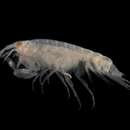Leucothoe incisa: Brief Summary
provided by wikipedia EN
Leucothoe incisa is an amphipod in the family Leucothoidae. It grows up to 7 millimetres (0.28 in) long, and is whitish in colour, but a yellowish green along the back, with intensely red eyes. It lives at depths of up to 60 metres (200 ft) along the Atlantic coast of Europe from the Mediterranean Sea to Scotland, and in the North Sea. It is part of group of sibling species, together with Leucothoe lilljeborgi and Leucothoe occulta.
- license
- cc-by-sa-3.0
- copyright
- Wikipedia authors and editors
Description
provided by World Register of Marine Species
An amphipod with a slender body coloured green or beige; up to 7 mm long and intensely red eyes. The species is characterised by two antennae of equal length and by large claws (first two pairs of legs).
Degraer, S.; Wittoeck, J.; Appeltans, W.; Cooreman, K.; Deprez, T.; Hillewaert, H.; Hostens, K.; Mees, J.; Vanden Berghe, E.; Vincx, M. (2006). The macrobenthos atlas of the Belgian part of the North Sea. Belgian Science Policy. D/2005/1191/3. ISBN 90-810081-6-1. 164 pp.
- license
- cc-by-4.0
- copyright
- WoRMS Editorial Board
Distribution
provided by World Register of Marine Species
In the 1976-1986 period Leucothoe incisa was only observed five times (maximum 60 ind./m2), which made it impossible to deduce a distribution patterns. In the 1994-2001 period the species had a wider distribution in the near-coastal zone, with the exception of the eastern coastal zone. The species occurred in densities up to 160 ind./m2.
Degraer, S.; Wittoeck, J.; Appeltans, W.; Cooreman, K.; Deprez, T.; Hillewaert, H.; Hostens, K.; Mees, J.; Vanden Berghe, E.; Vincx, M. (2006). The macrobenthos atlas of the Belgian part of the North Sea. Belgian Science Policy. D/2005/1191/3. ISBN 90-810081-6-1. 164 pp.
- license
- cc-by-4.0
- copyright
- WoRMS Editorial Board
Habitat
provided by World Register of Marine Species
Leucothoe incisa is found in sediments with different grain sizes, but displays a slight preference (relative occurrence: maximum 20%) for fine-grained sediments (median grain size 150 to 300 µm). The species furthermore prefers sediments with a mud content not exceeding 40%.
Degraer, S.; Wittoeck, J.; Appeltans, W.; Cooreman, K.; Deprez, T.; Hillewaert, H.; Hostens, K.; Mees, J.; Vanden Berghe, E.; Vincx, M. (2006). The macrobenthos atlas of the Belgian part of the North Sea. Belgian Science Policy. D/2005/1191/3. ISBN 90-810081-6-1. 164 pp.
- license
- cc-by-4.0
- copyright
- WoRMS Editorial Board

